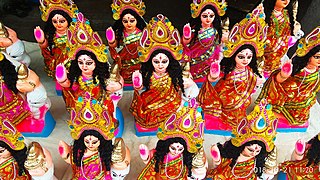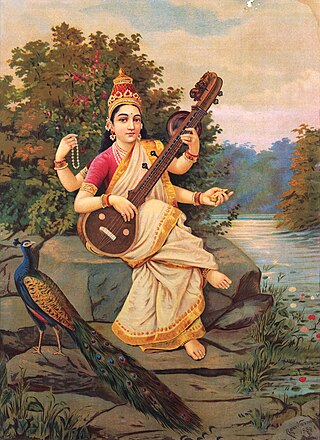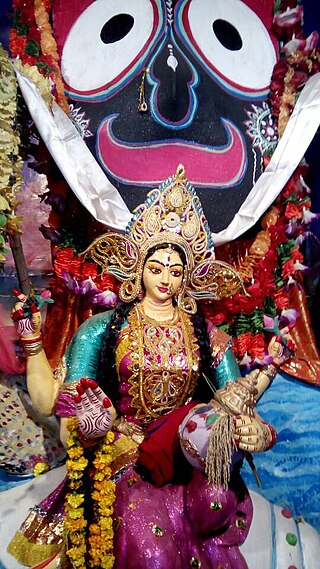
The three-week-long Nanda Devi Raj Jat is a pilgrimage and festival of Uttarakhand. India. The Raj-Jaat is celebrated in Chamoli Garhwal district, and traditionally only the deities of Garhwal Division took part in it. Sometimes, during the peaceful periods between the Kingdoms of Garhwal and Kumaun, the Goddess "Nanda of Almora" was invited and took part in the Raj-Jaat, while mostly there were separate Nanda-Sunanda fairs in Kumaun. Off late, after the formation of Uttarakhand, the state Government has been trying bring the people from Garhwal and Kumaun together for celebrations and fairs. Hence, in the Nanda Devi Raj Jaat held in the year 2000, the goddess "Almora ki Nanda" took part after 90 years and a number of other deities from Kumaun accompanied her. To facilitate this change, even the traditional route of the Yatra was tweaked and an additional stop with a detour was added, i.e. Nanadakesri. It is at this point, that the deities and devotees from Kumaon assimilate with the main Jaat. Now people from the entire Garhwal division-Kumaon division, as well as other parts of India and the world participate in Nanda Devi Raj Jat yatra

The Mangaladevi Temple is a Hindu temple at Bolara in the city of Mangalore in the Indian state of Karnataka. It is situated about three kilometres southwest of the city centre. The temple is dedicated to the Hindu goddess Shakti / Parvati in the form of Mangaladevi, the presiding deity from whom the city derives its name.

Sharad Purnima is a religious festival celebrated on the full moon day of the Hindu lunar month of Ashvin, marking the end of the monsoon season. The full moon night is celebrated in different ways in various cultural regions across Indian subcontinent.

Vasant Panchami, also rendered Vasanta Panchami and Saraswati Puja in honour of the Hindu goddess Saraswati, is a festival that marks the preparation for the arrival of spring. The festival is celebrated in Indian religions in different ways depending on the region. Vasant Panchami also marks the start of preparation for Holika and Holi, which take place forty days later. The Vasant Utsava (festival) on Panchami is celebrated forty days before spring, because any season's transition period is 40 days, and after that, the season comes into full bloom.

Kanaka Durga Temple, officially known as Sri Durga Malleswara Swamyvarla Devasthanam, is a Hindu temple dedicated to Kanaka Durga. The deity in this temple is also popularly referred as Kanaka Durga. The temple is located in Vijayawada, Andhra Pradesh, India on the Indrakeeladri hill on the banks of Krishna River. Kaalika Purana, Durgaa Sapthashati and other Vedic literature have mentioned about Kanaka Durga on the Indrakeelaadri and have described the deity as Swayambhu, (self-manifested) in Triteeya Kalpa.

Ramnagar is a town and municipal board in the Nainital district of Kumaon in the state of Uttarakhand, India. It is located approximately 65 kilometres (40 mi) from Nainital, the headquarters of the district.

Hinglaj Mata, also known as Hinglaj Devi, Hingula Devi and Nani Mandir, is a Hindu temple in Hinglaj, a town on the Makran coast in the Lasbela district of Balochistan, and is the middle of the Hingol National Park. It is one of the 51 Shakti Peethas in Shaktism denomination of Hinduism. It is one of the two Shakti Peethas in Pakistan, the other one being Sharada Peeth. It is a form of Durga or Devi in a mountain cavern on the banks of the Hingol River. Over the last three decades the place has gained increasing popularity and became a unifying point of reference for Pakistan's many Hindu communities. Hinglaj Yatra is the largest Hindu pilgrimage in Pakistan. More than 250,000 people take part in the Hinglaj Yathra during the spring.

The Maa Sarala Temple is a Hindu temple in the district of Jagatsinghpur, Odisha, India. It is one of the eight most famous Shakta shrines of Odisha.
This article lists the traditional festivals and other cultural events in the Odisha region of India. Odisha celebrates 13 festivals in 12 months as the saying goes Bāra Māsare Tera Parba.

Kartika Purnima, also known as Kartika Pournami, is a Hindu, Sikh, and Jain cultural festival that is celebrated on purnima, the 15th day of the lunar month Kartika. It falls on November or December of the Gregorian calendar and is also known as Tripurari Purnima or Deva-Deepavali, the gods's festival of lights. Karthika Deepam is a related festival that is celebrated in South India and Sri Lanka on a different date. It follows Diwali by about 15 days.

Lakshmi Puja or Lokkhi Pujo is a Hindu occasion for the veneration of Lakshmi, the Goddess of Prosperity and the Supreme Goddess of Vaishnavism. The occasion is celebrated on the amavasya in the Vikram Samvat Hindu calendar month of Ashwayuja or Kartika, on the third day of Deepavali (Tihar) in Nepal and most parts of India. In Odisha, Assam, Bengal this puja is celebrated five days after Vijaya Dashami.

ISKCON Vrindavan, also called Sri Krishna Balaram Mandir, is one of the major ISKCON temples in the world. It is a Gaudiya Vaishnava temple located in the city of Vrindavan, Mathura district, in the Indian state of Uttar Pradesh. The temple is dedicated to the Hindu gods Krishna and Balarama. The other deities of temple are Radha Krishna and Gauranga Nityananda.

Kali Puja, also known as Shyama Puja or Mahanisha Puja, is a festival originating from the Indian subcontinent, dedicated to the Hindu goddess Kali. It is celebrated on the new moon day of the Hindu calendar month of Ashwayuja or Kartika. The festival is especially popular in the region of West Bengal, and other places like Mithila, Jharkhand, Odisha, Assam, and Tripura, as well as the town of Titwala in Maharashtra, along with the neighbouring country of Bangladesh.

Baladevjew Temple is a Hindu temple in Ichhapur, Kendrapara, Odisha, India. Baladevjew (Balarama) is the main divinity. His siblings Jagannath and Subhadra are also worshipped in the Ratna Sinhasan in the main temple.

Tirunageswaram Naganathar Temple also known as Rahu Stalam is a Hindu temple dedicated to the deity Shiva, located in Tirunageswaram, a village in the outskirts of Kumbakonam, a town in Tamil Nadu, India. It is significant to the Hindu sect of Saivism as one of the temples associated with the nine planet elements, the Navagraha Stalas, and specifically Rahu. Shiva is worshiped as Naganathar, and is represented by the lingam. His consort Parvati is depicted as Piraisoodi Amman. The presiding deity is revered in the 7th-century Tamil Saiva canonical work, the Tevaram, written by Tamil saint poets known as the nayanars and classified as Paadal Petra Sthalam.
Here is a list of glossary of culture of India in alphabetical order:

The Jammu division is a revenue and administrative division of the Indian-administered Jammu and Kashmir in the disputed Kashmir region. It is bordered by the Kashmir division to the north. It consists of the districts of Jammu, Doda, Kathua, Ramban, Reasi, Kishtwar, Poonch, Rajouri, Udhampur and Samba. Most of the land is hilly or mountainous, including the Pir Panjal Range which separates it from the Kashmir Valley and part of the Great Himalayas in the eastern districts of Doda and Kishtwar. Its principal river is the Chenab.

The Nateshwori Temple is a Hindu temple of Devi Vagawoti located in the Sudurpaschim province of Nepal Triveni-07 Bajura. This temple is one of the sacred temples of Hindu faith.

Vaishno Devi Temple, also known as the Shri Mata Vaishno Devi Temple and Vaishno Devi Bhavan, is a Hindu temple located in Katra, Jammu and Kashmir, dedicated to Vaishno Devi, a manifestation of Mahakali, Mahalakshmi, and Mahasarasvati. It is located on the Trikuta mountain at 5,000 feet / 1,500 meters elevation. The Shakti tradition considers it to be a Shakti Pitha. The temple is governed by the Shri Mata Vaishno Devi Shrine Board (SMVDSB) and has been chaired by the Governor of Jammu and Kashmir since August 1986.





















